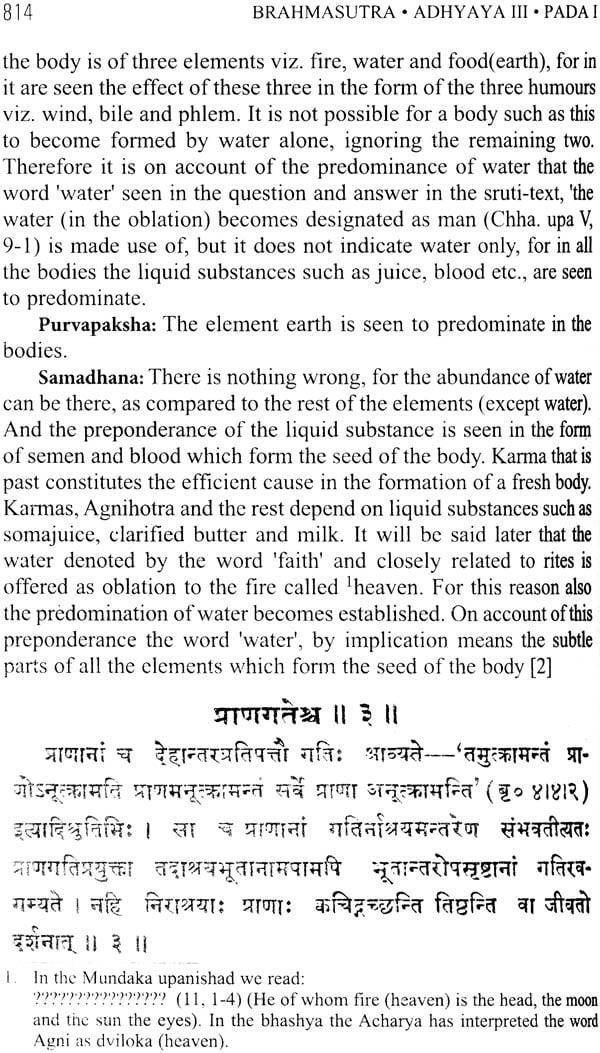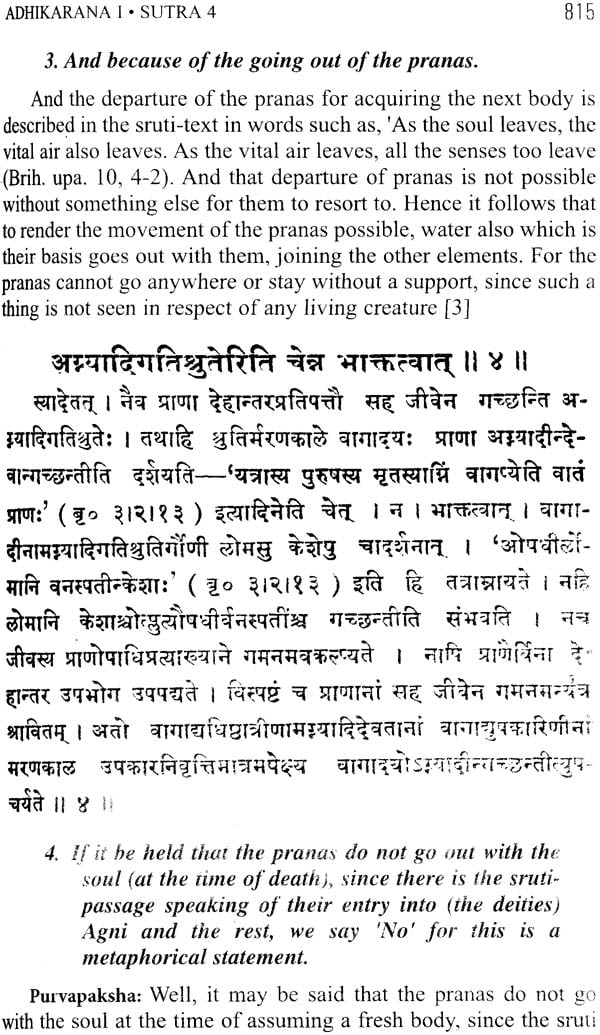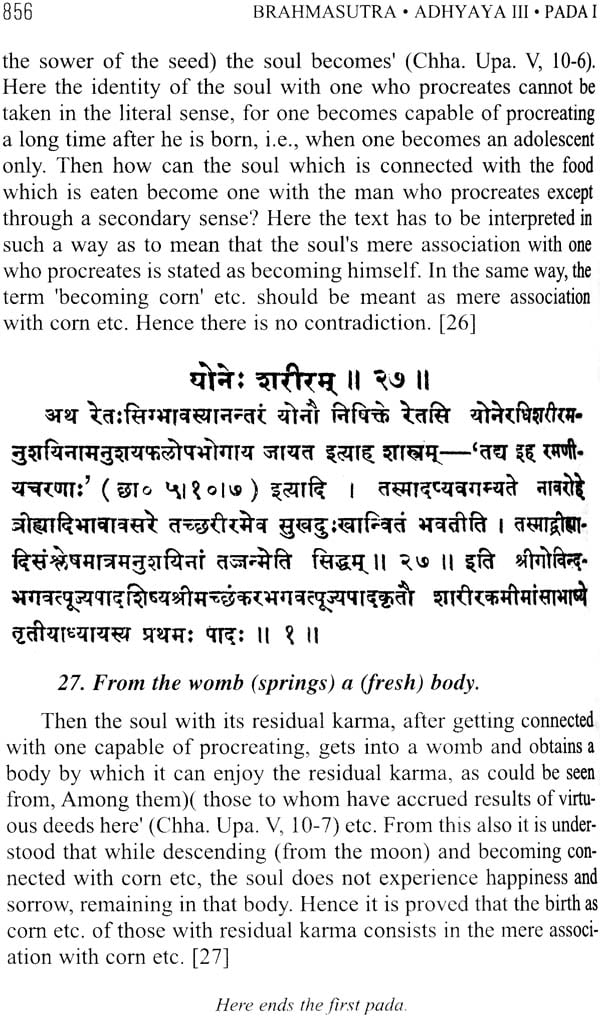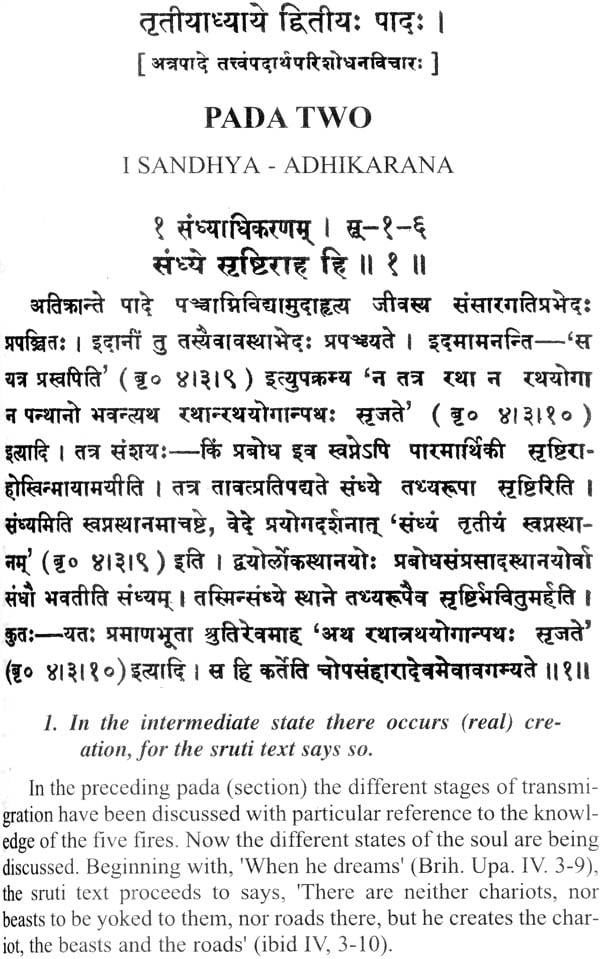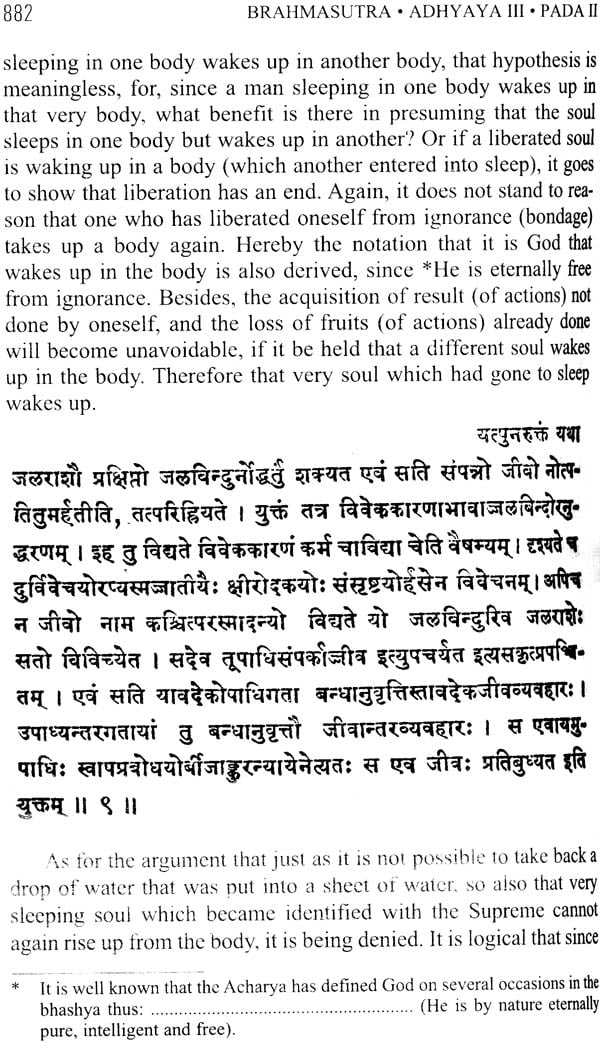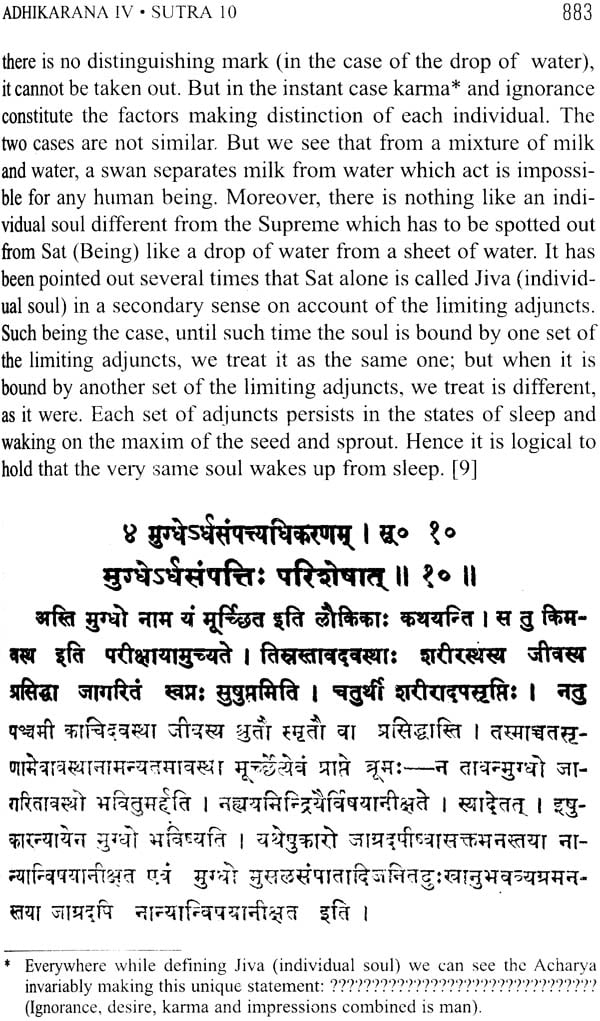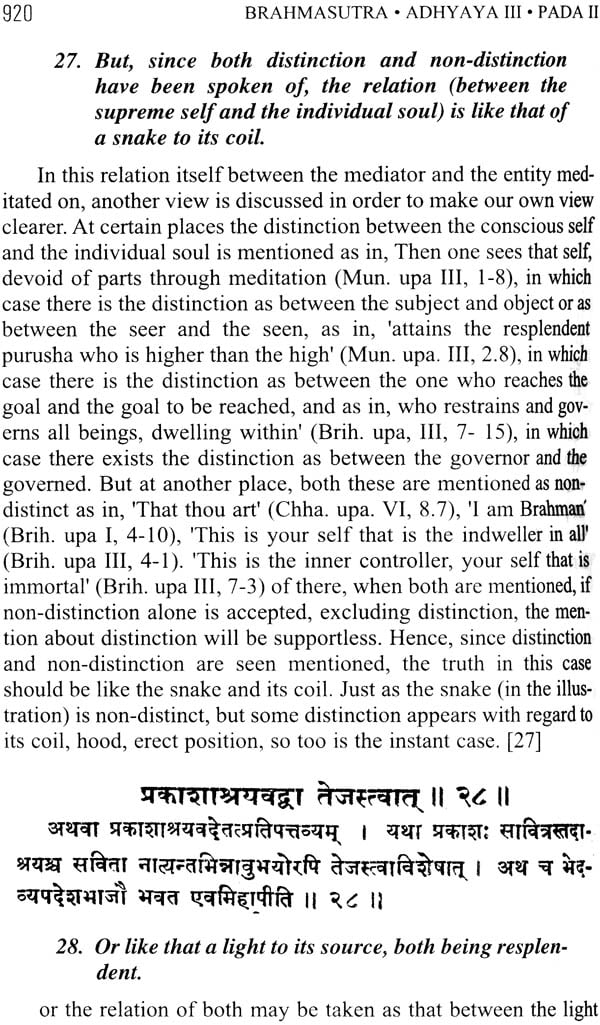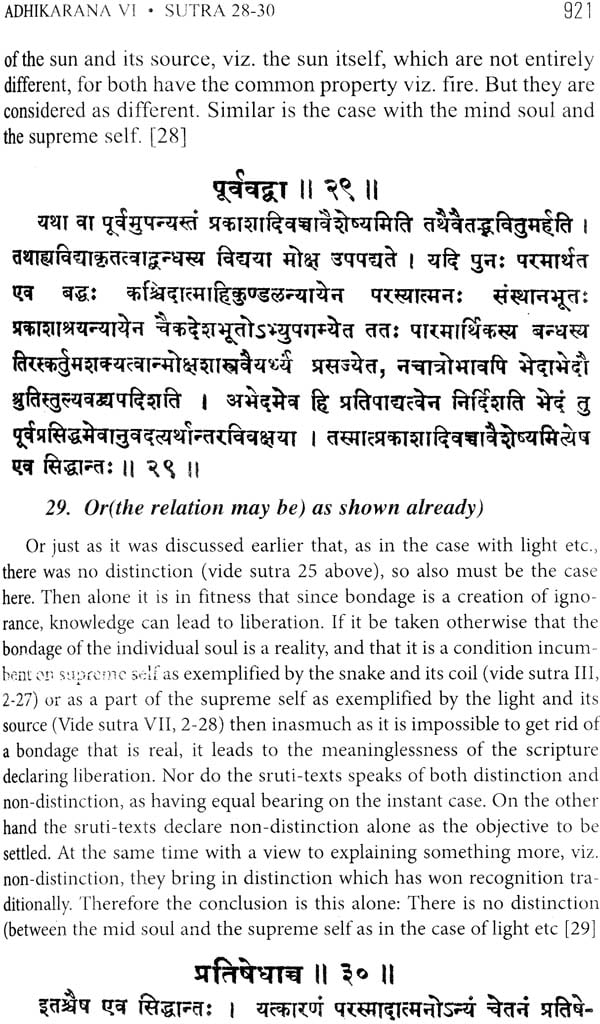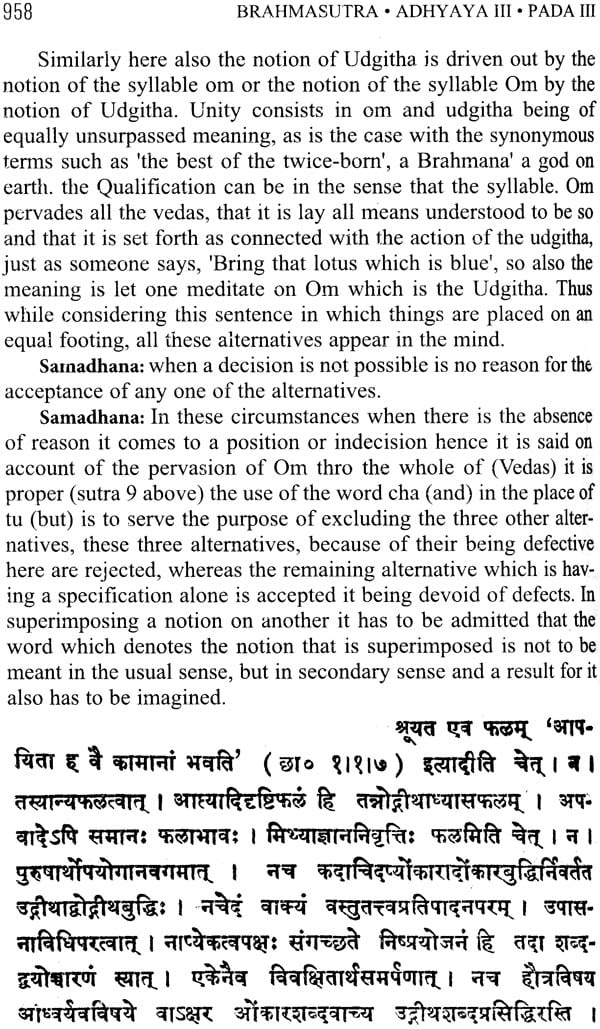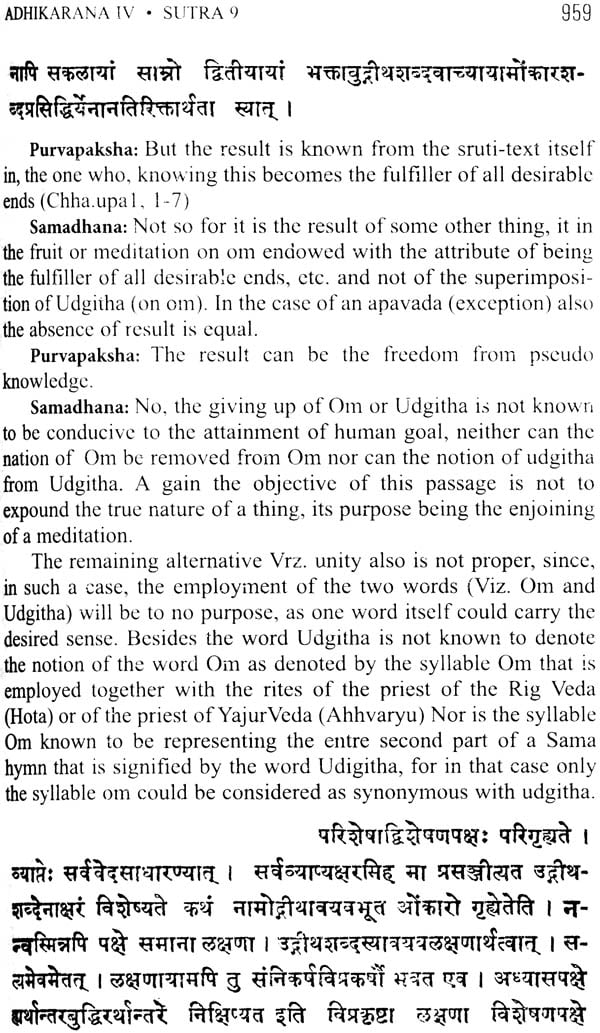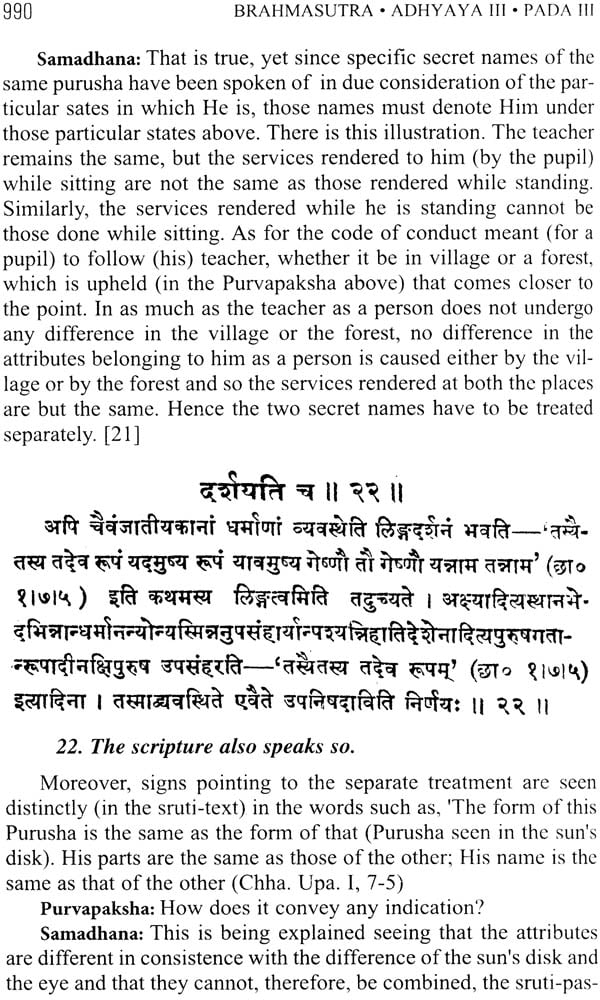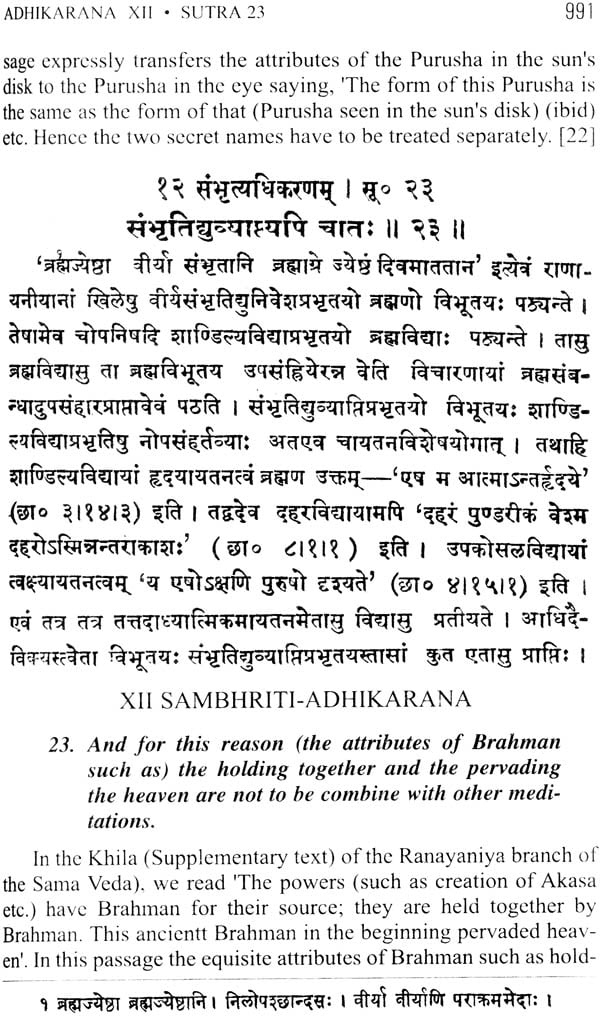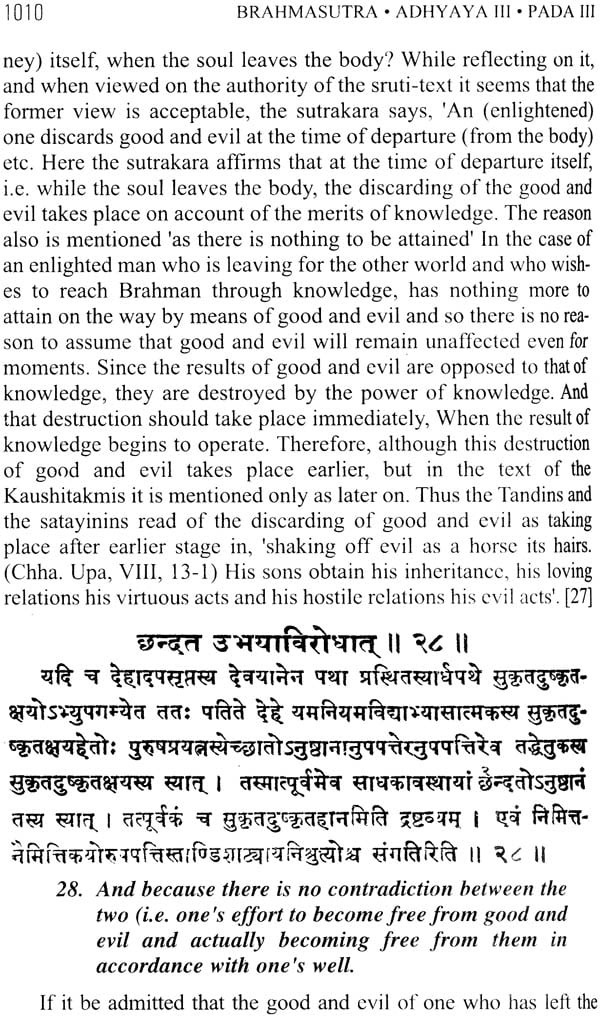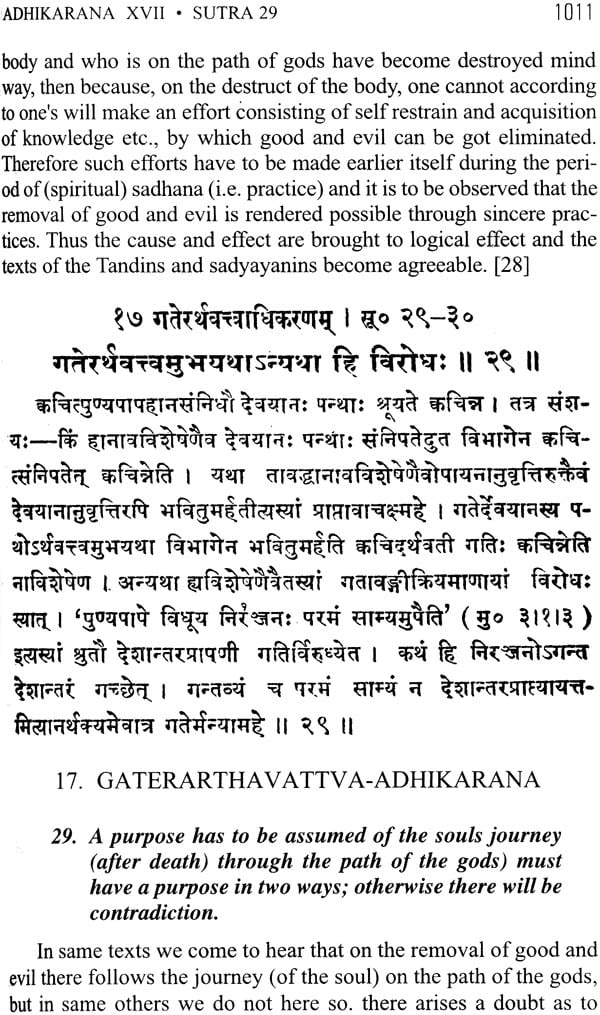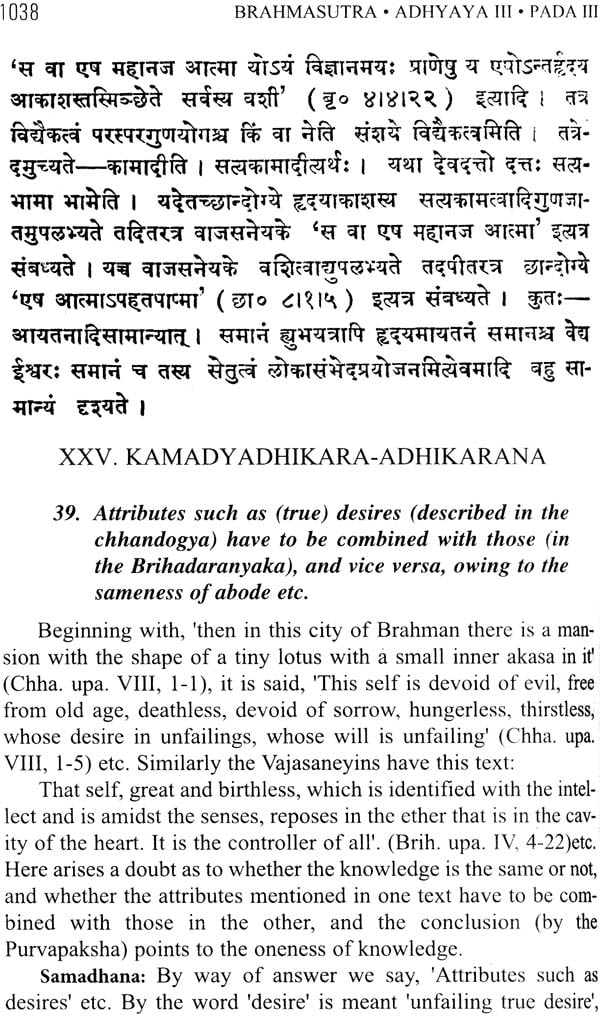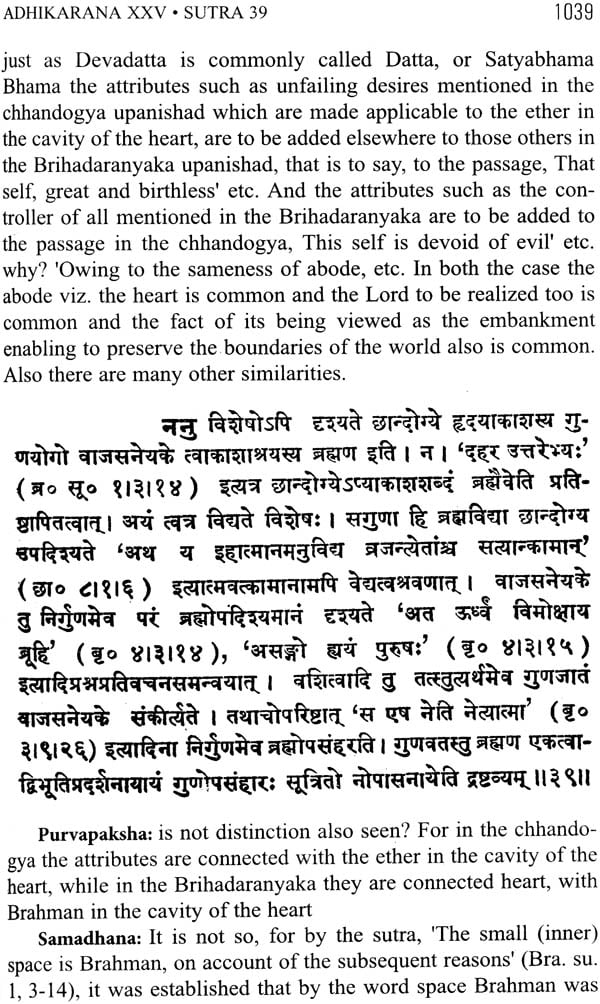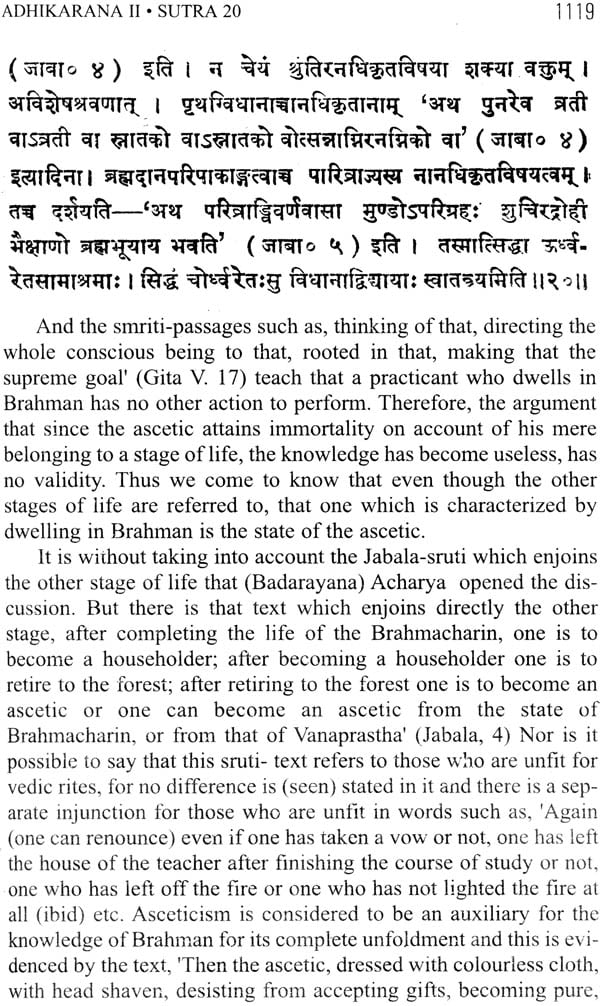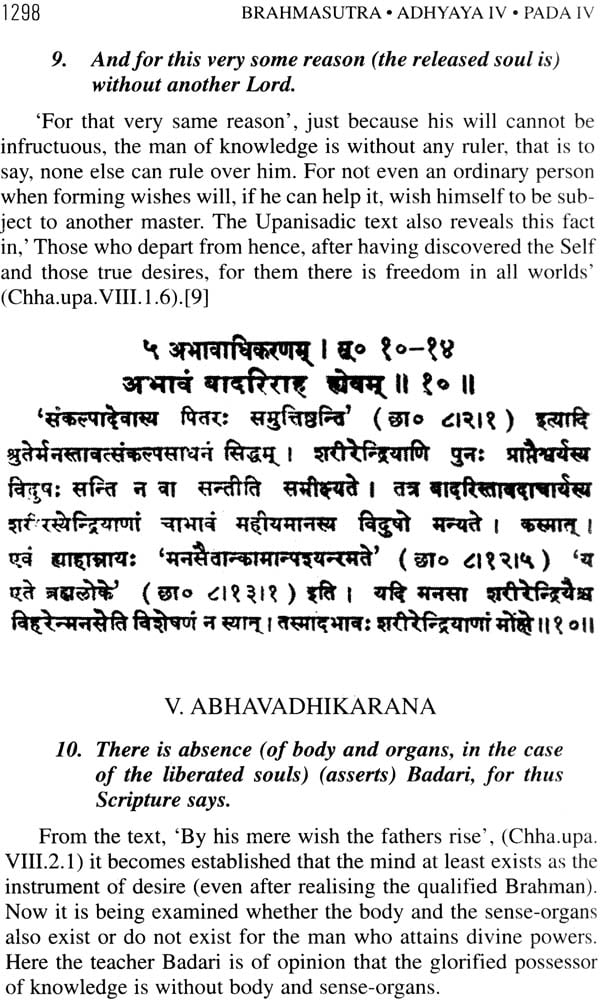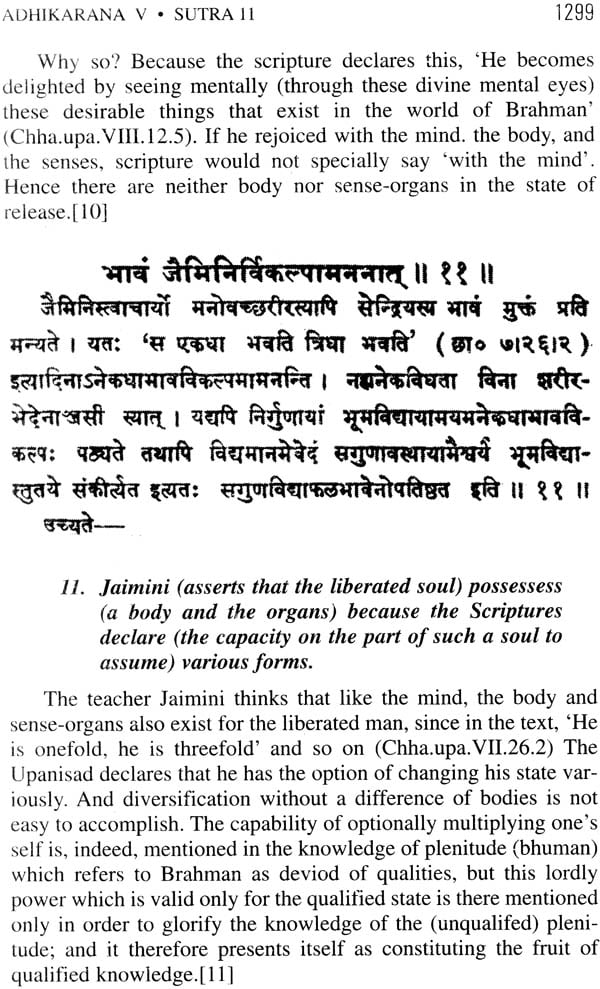
Prasthanathraya: Shankaracharya's Commentary on the Brahmasutra (The Only Edition with Both the Sanskrit Text of the Bhashya and Its English Translation)
Book Specification
| Item Code: | NAC864 |
| Author: | Vidyabhooshanam Vidyvachaspati V. Panoli |
| Publisher: | Mathrubhumi Grandhavedi |
| Language: | The Only Edition with Sanskrit Text of The Bhashya and Its English Translation |
| Edition: | 2011 |
| ISBN: | 9788182650541 |
| Pages: | 1343 |
| Cover: | Hardcover |
| Other Details | 8.3 Inch X 5.5 Inch |
| Weight | 1.48 kg |
Book Description
The Brahmasutra composed by Sri Badarayana Acharya is not only a great book but also a goldy book. The terse aphorisms which the text holds in its bosom are clothed in the bhashya of which the style is climically precise and the approach rigorously logical. The bhashyakara Sri Sankara has immortalized these sutras by his superb interpretation which reveals the Acharya himself as critically intelligent and intelligently critical from one end of the bhashya to the other.
This is the one text which often reminded me of my limitation. Certainly in the vast range of philosophy the Brahmasutra is the hardest nut to crack. What is the objective of this work? Of course it is to establish the Advaita Vedanta as a flawless system of thought. In order to accomplish it the whole force is brought to bear upon establishing the following:
(a) The Darsanas other than the Advaita Vedanta are faulty with errors beyond reconciliation and hence they cannot stand to reason.
(b) Some of the Statements or declarations in the Vedanta texts themselves which are seemingly contradictory are not contradictory at all in the light of discriminative thinking and pure reason.
(c) The Claims made with regard to moksha (liberation) by the authors of other systems are not acceptable in as they fail to satisfy reason.
Moreover the Brahmasutra refutes all the doctrines that contradict the right knowledge and establishes the true sense of the Vedanta texts.
Now the facts mentioned above will serve as a pointer to the import of the text. There is a statement in the Jaimini sutras that the Veda is meant to enjoin rites and that the other parts (of the Veda) are useless. This has been refuted by Sri Badarayana. Similarly the followers of the Sankhya system hold that the unintelligent Pradhana is the cause of the universe. This is discussed in 1-1-15 of the Brahmasutra and in the end it has been settled that Pradhana cannot be the cause. Again the sankhyas point out that Pradhana is equivalent to Avyakta which is spoken of in the katha Upanishad. This is refuted in Brahmasutra.
In the Svetasuvatara Upanishad Sankhya and yoga have been spoken of as means of realization. The exact sense conveyed by the above Upanishadic text has been explained in Brahmasutra and it goes against the theories of the Sankhyas and yogins. Similarly the argument of the sankhyas that the word ajaa which represents Pradhana (of their doctrine) is found used in the Upanishad in the same sense that the sankhya theory therefore enjoys the sanction of the Veda has been in Adhikarana 9 and 10 of 1,4-2 of the Brahmasutra. The refutation advances still further as explained below:
The fourth pada (of the first Adhyaya) ends with the following observation of the acharya
Because of seeing (thinking) Pradhana does not constitute the cause because it is disagreeable to the scripture>
Beginning with the above sutra the doctrine of Pradhana was brought forward and refuted again and again by the Sutras themselves. This became necessary because the Vedanta texts have in them certain passages bearing semblances of interferential marks which may appear to the opponents as supporting their doctrine. Since that doctrine admits the non difference of cause and effect it comes very near to the views of the Vedanta texts. Great pains have therefore been taken in refuting it. But such has not been the case in repudiating the atomic theory (of Kanada) as the cause. These theories are to be refuted since they are opposed to the doctrine of Brahman as the cause some Vedic connotations may appear to the opponents as supporting their doctrine. Hence the same arguments are directed towards them also. Badarayana acharya opposes the origination of the Jiva for it has not source.
This book which is designed for the advanced study in philosophy makes mention of the views of such thinkers as Asmaratya oudulomi and Kasakrishan who do not generally figure in minor texts of philosophy.
Asmaratya admits non difference between the individual self and the supreme self. His efforts consisted in bringin in the relationship existing between a cause and its effect whereas oudulomi holds that the declaration of non difference between Jiva and Paramatman appears at the outset because the soul on leaving the body finds identity with the supreme self. His views is in harmony with that thou art. According to this view immortality results from the knowledge of the self. But if he individual self is a modification as held by Asmaratya in as much as the modification gets itself lost on becoming dissolved in its cause the attainment of immortality through knowledge does not stand to reason. Kasakrishna advocates that the supreme Lord in his unmodified state is the individual self and nothing else.
Coming to the present volume it may be said that six padas (i.e. four padas of the first Adhyaya and the two of the second) have only been covered by it. In order to facilitate the grasp of these padas a gist is given before the commencement of each pada.
As regards the method of the bhashya, it may be stated that the bhashya presents short statements which it again explains as warranted by contexts. What is most peculiar to the bhashya is that there is an imaginary disputant to whom it is addressed directly. This imaginary disputant actually plays the role of an opponent the objections raised by whom are given as Purvapaksha and the replies to these objections as Samadhana.
In all humility I must admit that it was the grace of God and my Gums that has enabled me to render the Gita-bhashya of Sri Sankara as well as his bhashyas on the ten major Upanishads with all explanatory notes and footnotes. In all these published works the words Purvapaksha and Samadhana have been used invariably, whenever occasions arose for their use, in the sense pointed out above. Since the terms such as Maya, Atman, Brahman are current even in the writings published by the Westerners, the use of terms such as Purvapaksha, Samadhana etc., I think, is justifiable since they render comprehension of the desired sense easy. But in exceptional cases the words ‘opponent’ and ‘reply’ (or explanation) have also been used as warranted by peculiar circumstances as those words alone would reveal the idea in those peculiar contexts.
My revered master, Sahitya Kesari Pandit Gopalan Nair gave me in 1956 a copy of his rendering in Malayalam of the first Adhayaya of Brahmasutra. Truly speaking, he gave me the key of the sanctuary, although I was too inexperienced to operate it. Later on, the remaining volumes were also given to me by him as and when they were brought out. I do not say, it was all a joy to go through them; rather it seemed to be walking over thorns. The text was full of intricacies and riddles. Unless and until one is acquainted with the teachings of the Upanishads, it is well-nigh impossible to get a grasp of the import of the Brahmasutra. It took me a pretty long period to cover the major Upanishads before coming to the Brahmasutra. But this gave me one definite advantage. I could use my own rendering of the Upanishads and the Gita with the bhashyas of Sri Sankara there on, while translating the innumerable passages from those texts cited by the Acharya in the Brahniasutra-bhashya.
The bhashya of Sri Sankara on the Gita, though not easily understandable, as pointed out at the very outset by the Acharya himself, can be grasped with some effort, but the bhashya on the Brahmasutra seems to be the hardest and of unfathomable import, filled with speculations that soar to inaccessible heights. And what about the bhashyas on the Upanishads? Certainly, they are not so tough as the bhashya on the Brahmasutra.
Three decades back I heard an eminent scholar of Vedantic studies say that Adi Sankara had written only one bhashya and that it was the sutra-bhashya. But he did not substantiate his views by giving reasons, It is simply impossible to agree with this view. Although the language, the construction of sentences and the style in the sutra-bhashya are more rigid and tough, as also more rigorously logical than the bhashya on the Gita and Upanishads, the imageries, definitions, illustration phrases etc. that one comes across in the Gita bhashya and the Upanishad bhashyas bear semblances to those found at certain place in the sutra bhashya also.
However one should not fail to observe some glaring differences in the interpretation. To cite for instance Gayathri mantra is said to have three padas of eight syllables each in the Brihadarayaka bhasya (Brahmana 14, AdhayayaV) where as in Brahmasutra bhashya it is spoken of as having four padas of six syllables each. Not specific reason is seen cited for this variation.
Another peculiarity that is observed is this anandamaya (the self made of bliss) is discussed in detail in Taittiriya Upanishad (11-5 onwards) in the Brahmasutra the particular sutra which has a bearing on Anandamaya runs as follows
Besides it teaches the union of this with that (Anandamaya) Bra. Su 1.1 6-19
Here sir Badaryana Acharya seems to be in favor of the interpretation that Anandmaya is the supreme self itself. Although the Bhashya starts to discuss the point in accordance with the spirit of the Sutra other arguments are brought in late on by the acharya to establish that Anandamaya is not the supreme self. Incidentally it may be pointed out that Sri Ramajuja Acharya is of the view that Anandamaya is not Jiva but Brahman that is distinct from the former.
Now In all fitness of things let us focus our attention on the author himself.
Badarayana Acharya is a great name in Indian Philosophy. We have only very little information about the period in which he lived. It is peculiar with the Hindu race to believe that Badarayana is none other than the great Vyasa who composed the Mahabharata. If anyone dares contradict this faith he will certainly incur the displeasure of all the rest. Why? Because we are disinclined to deviate from the rut through which tradition has moved uninterruptedly never once pausing to ponder over the right and wrong of our own act.
We should not be carried away or governed by superstitions. Superstition is the enemy of progress. When the stream of reason dries up a man becomes devoid of the light of life of the melody of life’s music. Sri Sankara the great commentator India ever saw was never inclined to compromise with superstition of any kind. In the vast range of the magnum upus known as the Sanskara Bhashya three cannot be seen a single occasion when he hugged superstition to his breast. Rather time and again he harped upon this one evil saying kill superstition if you want to see light destroy its root and branch if you wish to reach where endless joy abideth.
In the perspective of what is explained above let us by diligently applying our wit make an attempt to know whether Badarayana Acharya (the author of Brahmasutra) and Vyasa Acharya are one and the same person.
| Publisher’s Note | xiii |
| Blessings Sri Jagadguru Sankaracharya of Sringeri | xvii |
| Extract from the forward of Justice Shri V R Krishna Iyer | xx |
| Opinions on Upanishads in Sankara’s Onw words | xxi |
| Author’s Preface | xxiv |
| An Epilogue | xxx |
| At the Lotus Feet of Shri Sankara | xxxi |
| The Brahmasutra Sankara Bhashya | |
| Adhyaya One | |
| Introduction | 6 |
| Pada Two | |
| I. Jijnasa - Adhikarana | 11 |
| II. Jammadi - Adhikarana | 19 |
| III. Sastrayonitva - Adhikarana | 25 |
| IV. Samanvaya - Adhikarana | 27 |
| V. Ikshatya - Adikarana | 62 |
| VI. Anandamaya - Adhikarana | 87 |
| VII. Antaradhikarana | 111 |
| VIII. Akashaadhikarana | 117 |
| IX. Pranaadhikarana | 122 |
| X. Jyothischaranaadhikarana | 128 |
| XI. Pratardanaadhikarana | 142 |
| Pada Two | |
| I. Sarvatraprasiddhi - Adhikarana | 158 |
| II. Attra - Adhikarana | 175 |
| III. Guhapravishthaadhikarana | 178 |
| IV. Antara - Adhikarana | 188 |
| V. Antaryami - Adhikarana | 198 |
| VI. Adrisyatva - Adhikarana | 205 |
| VII. Vaisvanara - Adhikarana | 217 |
| Pada Three | |
| I. Dyubhuadi - Adhikarana | 233 |
| II. Bhuma - Adhikarana | 245 |
| III. Akshara - Adhikarana | 256 |
| IV. Ikshatikarmavyapadesa - Adhikarana | 260 |
| V. Dahara - Adhikarana | 264 |
| VI. Anukritya - Adhikarana | 291 |
| VII. Pramita - Adhikarana | 296 |
| VIII. Devata - Adhikarana | 300 |
| IX. Apasudra - Adhikarana | 337 |
| X. Kampana - Adhikarana | 346 |
| XI. Jyoti - Hadhikarana | 350 |
| XII. Arthantaratuavyapadesa - Adhikarana | 353 |
| XIII. Sushuptyhutkranti - Adhikarana | 354 |
| Pada Four | |
| I. Anumanika - Adhikarana | 360 |
| II. Chamasa - Adhikarana | 386 |
| III. Sankhyopa Sangraha - Adhikarana | 393 |
| IV. Karanattva - Adhikarana | 402 |
| V. Balakya - Adhikarana | 411 |
| VI. Vakyanvaya - Adhikarana | 420 |
| VII. Prakriti - Adhikarana | 434 |
| VII. Sarvavyakhyana - Adhikarana | 443 |
| Adhyaya Two | |
| Pada One | |
| I. Smriti - Adhikarana | 444 |
| II. Yogapratyukti- Adhikarana | 454 |
| III. Vilakshanatva - Adhikarana | 458 |
| IV. Sishtaparigraha- Adhikarana | 483 |
| V. Bhoktrapathi - Adhikarana | 484 |
| VI. Aranbhana - Adhikarana | 487 |
| VII. Itharavyapadesa - Adhikarana | 518 |
| VIII. Upasamhara – Darsana - Adhikarana | 523 |
| IX. Kritsnprasakti - Adhikarana | 527 |
| X. Sarvopeta - Adhikarana | 535 |
| XI. Prayojanavattva - Adhikarana | 537 |
| XII. Vaishamyanaigrimya - Adhikarana | 540 |
| XIII. Saravadharmopapathi - Adhikarana | 545 |
| Pada Two | |
| I. Rachananupapatti - Adhikarana | 546 |
| II. Mahaddirgha - Adhikarana | 569 |
| III. Paramanu Jagad - Akaranatva - Adhikarana | 575 |
| IV. Samudaya - Adhikarana | 595 |
| V. Abhava - Adhikarana | 615 |
| VI. Ekasminnasambhava - Adhikarana | 630 |
| VII. Patya - Adhikarana | 639 |
| VIII. Utpattiasambhava - Adhikarana | 647 |
| Pada Three | |
| I. Viyad - Adhikarana | 654 |
| II. Matariswa - Adhikarana | 675 |
| III. Asambhava - Adhikarana | 677 |
| IV. Teja - Adhikarana | 678 |
| V. Adhikarana | 681 |
| VI. Prithvyadhikara - Adhikarana | 682 |
| VII. Tadabhidhyana | 685 |
| VIII. Viparyaya | 686 |
| IX. Antaravijnana - Adhikarana | 688 |
| X. Characharavyapasraya Adhikarana | 691 |
| XI. Atma Adhikarana | 693 |
| XII. Jna Adhikarana | 700 |
| XIII. Utkrantigati Adhikarana | 702 |
| XIV. Kartee Adhikarana | 724 |
| XV. Thaksha Adhikarana | 729 |
| XVI. Parayatta Adhikarana | 738 |
| XVII. Amsa Adhikarana | 742 |
| Pada Four | |
| I. Pranotpatti - Adhikarana | 762 |
| II. Saptagati - Adhikarana | 771 |
| III. Prananuttva - Adhikarana | 779 |
| IV. Prana Sraishthya - Adhikarana | 780 |
| V. Vayukriya - Adhikarana | 783 |
| VI. Shreshtanuttva - Adhikarana | 790 |
| VII. Jyotiradi - Adhikarana | 791 |
| VIII. Indriya - Adhikarana | 796 |
| IX Samjnamurtiklirpti - Adhikarana | 801 |
| Adhyaya Three | |
| Pada One | |
| I. Tadantara Pratipatti - Adhikarana | 809 |
| II. Kritatyaya - Adhikarana | 825 |
| III. Anishtradikarya - Adhikarana | 838 |
| IV. Sabhavyapatti - Adhikarana | 847 |
| V. Natichira - Adhikarana | 849 |
| VI. Anyadhishthita - Adhikarana | 851 |
| Pada Two | |
| I. Sandhya - Adhikarana | 857 |
| II. Tadabhava - Adhikarana | 870 |
| III. Karmanusmriti Sabdavidhi - Adhikarana | 879 |
| IV. Mugdhe Ardhasampatti - Adhikarana | 884 |
| V. Ubhayalinga - Adhikarana | 888 |
| VI. Prakritaitavattva - Adhikarana | 909 |
| VII. Para - Adhikaranam | 923 |
| VIII. Phala - Adhikaranam | 933 |
| Pada Three | |
| I. Sarvavedantapratyaya - Adhikarana | 938 |
| II. Upasamhara - Adhikarana | 948 |
| III. Anyathathva - Adhikarana | 950 |
| IV. Vyapti - Adhikaranava | 956 |
| V. Sarvaabheda - Adhikarana | 961 |
| VI. Anandadi - Adhikarana | 964 |
| VII. Adhyana - Adhikarana | 967 |
| VIII. Atmagrihita - Adhikarana | 971 |
| IX. Karyakhyana - Adhikarana | 979 |
| X. Samana - Adhikarana | 984 |
| XI. Sambandha - Adhikarana | 988 |
| XII. Sambhriti - Adhikarana | 991 |
| XIII. Purushadhikarana | 994 |
| XIV. Vedhadi - Adhikarana | 997 |
| XV. Hani - Adhikaranam | 1002 |
| XVI. Samparaya - Adhikarana | 1009 |
| XVII. Gaterarthavattva - Adhikarana | 1011 |
| XVIII. Aniyama - Adhikarana | 1014 |
| XIX. Yavadadhikara - Adhikarana | 1017 |
| XX. Aksharadhy - Adhikarana | 1024 |
| XXI. Iyad - Adhikarana | 1026 |
| XXII. Antara - Adhikaranam | 1029 |
| XXIII. Vyathihara - Adhikarana | 1032 |
| XXIV. Satyadi - Adhikarana | 1034 |
| XXV. Kamadyadhikara - Adhikarana | 1038 |
| XXVI. Adara - Adhikarana | 1041 |
| XXVII. Tannirdharana - Adhikarana | 1046 |
| XXVIII. Pradhana - Adhikarana | 1051 |
| XXIX. Lingabhuyastva - Adhikarana | 1056 |
| XXX. Aikatmya - Adhikarana | 1068 |
| XXXI. Angavabadha - Adhikarana | 1074 |
| XXXII. Bhumajayastva - Adhikarana | 1078 |
| XXXIII. Sabdadibheda - Adhikarana | 1081 |
| XXXIV. Vikalpa - Adhikarana | 1085 |
| XXXV. Kamya - Adhikarana | 1087 |
| XXXVI. Yathasraya - Adhikarana | 1088 |
| Pada Four | |
| I. Purushartha - Adhikarana | 1093 |
| II. Paramarsa - Adhikarana | 1110 |
| III. Stutimatra - Adhikarana | 1120 |
| IV. Pariplava - Adhikarana | 1123 |
| V. Agnindanadi - Adhikarana | 1125 |
| VI. Sarvapeksha - Adhikarana | 1126 |
| VII. Sarvannanumati - Adhikarana | 1131 |
| VIII. Asramakarma - Adhikarana | 1136 |
| IX. Vidhura - Adhikarana | 1140 |
| X. Tadbhuta - Adhikarana | 1143 |
| XI. Adhikara - Adhikarana | 1145 |
| XII. Bahiradhikarana | 1148 |
| XIII. Swami - Adhikarana | 1149 |
| XIV. Sahakaryantaravidhi - Adhikarana | 1152 |
| XV. Anavishkara - Adhikarana | 1157 |
| XVI. Aihika - Adhikarana | 1159 |
| XVII. Muktiphala - Adhikarana | 1163 |
| Adhyaya Four | |
| Pada One | |
| I. Yathasraya Avritti- Adhikarana | 1166 |
| II. Atmatvopasana - Adhikarana | 1177 |
| III. Pratheekadhikarana | 1182 |
| IV. Brahmadristhi Adhikarana | 1184 |
| V. Adithyadimathyadhikarana | 1188 |
| VI. Aseenadhikarana | 1195 |
| VII. Ekagradhikarana | 1197 |
| VIII. Aprayanadhikarana | 1199 |
| IX. Thadhigam - Adhikarana | 1201 |
| X. Itharasamsleshadhikarana | 1206 |
| XI. Anarabdhadhikarana | 1208 |
| XII. Agnihothradhikarana | 1211 |
| XIII. Vidjananasadhanadhikarana | 1213 |
| XIV. Itharakshapanadhikarana | 1217 |
| Padat Two | |
| I. Vagadhikarana | 1220 |
| II. Manodhikarana | 1223 |
| III. Adhyakshadhikarana | 1225 |
| IV. Asrityupakramadhikarana | 1230 |
| V. Samasaravyapadesadhikarana | 1232 |
| VI. Pratishedhadhikarana | 1235 |
| VII. Vagadilayadhikarana | 1240 |
| VIII. Avibhagadhikarana | 1241 |
| IX. Tadokodhikarana | 1242 |
| X. Tasmyadhikarana | 1244 |
| XI. Dakshinayanadhikarana | 1247 |
| Pada Three | |
| I. Archiradyadhikarana | 1250 |
| II. Vayvadhikarana | 1254 |
| III. Tadidadhikarana | 1257 |
| IV. Ativahikadhikarana | 1258 |
| V. Karyadhikarana | 1263 |
| VI. Apratikalambanadhikarana | 1284 |
| Pada Four | |
| I. Sampadyavirbhavadhikarana | 1287 |
| II. Avibhagena Drishtatvadhikarana | 1292 |
| III. Brahmadhikarana | 1293 |
| IV. Sankalpadhikarana | 1296 |
| V. Abhavadhikarana | 1298 |
| VI. Pradhpadhikarana | 1301 |
| VII. Jagadvyaparadhikarana | 1305 |
